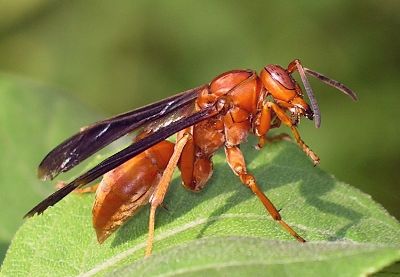by Valerie
March, 2005Red Wasp Our featured animal this month is the red wasp (Polistes carolina). This insect is a type of paper wasp that makes umbrella shaped nests attached by a small stem and having honeycomb-like cells opening to the bottom. The red wasp is a social insect, with each nest occupied by a single queen that lays eggs and similar looking female workers who are her daughters. Males, born only later in the season, perform the sole duty of mating with future queens. Most members of a nest die at the end of summer, but the mated queens hide in safe places through the winter and survive to start new colonies the next spring. The females are capable of giving a painful sting but males cannot, as the stinger is actually a modified ovipositor. While red wasps are not particularly aggressive, they tend to build their nests in hidden locations and will sting when these are disturbed. The stings are not really very bad. I was stung in the back when one got caught in my hair and I then sat down on our sofa, and I also have been stung several times when I accidentally grab a nest as I'm pruning shrubs. Larry recently felt a particularly sharp prick, presumably from the large potted asparagus fern we were moving. Upon closer inspection, though, it turned out that there was a wasp nest under the rim. In all instances, the sting hurts a little at first, then quickly fades away after less than 5 minutes. The stings may, however, produce more severe reactions in people who are allergic to them. Red wasps are considered beneficial because they consume caterpillars. The adults actually eat nectar from flowers, but they spend much of their time hunting in order to feed the grubs developing in their nest. If a wasp finds a caterpillar that is too large to carry away, it will cut it up on the spot and sometimes eat some and carry back just a portion to the nest. The bits of flesh are chewed up before being fed to the developing grubs. It is surprising how quickly the wasps are capable of disposing of a caterpillar after they locate it. I've spent time watching the paper wasps that live in our yard as they come to drink at our ponds during the hot part of the summer. It seems that only one insect at a time makes the trip to water, or that the same one goes back and forth a whole lot. A wasp will fly from the direction of the nest, land on the vegetation in the pond, spend about 30 seconds drinking, then fly back in the direction from which it came. This is repeated about 3-5 minutes later. Sometimes, there is a succession of 4 or 5 such visits. I've also seen both the red and the striped paper wasps (another common Polistes species in our yard) visiting the water at the same time. They seem to take no notice of each other. |